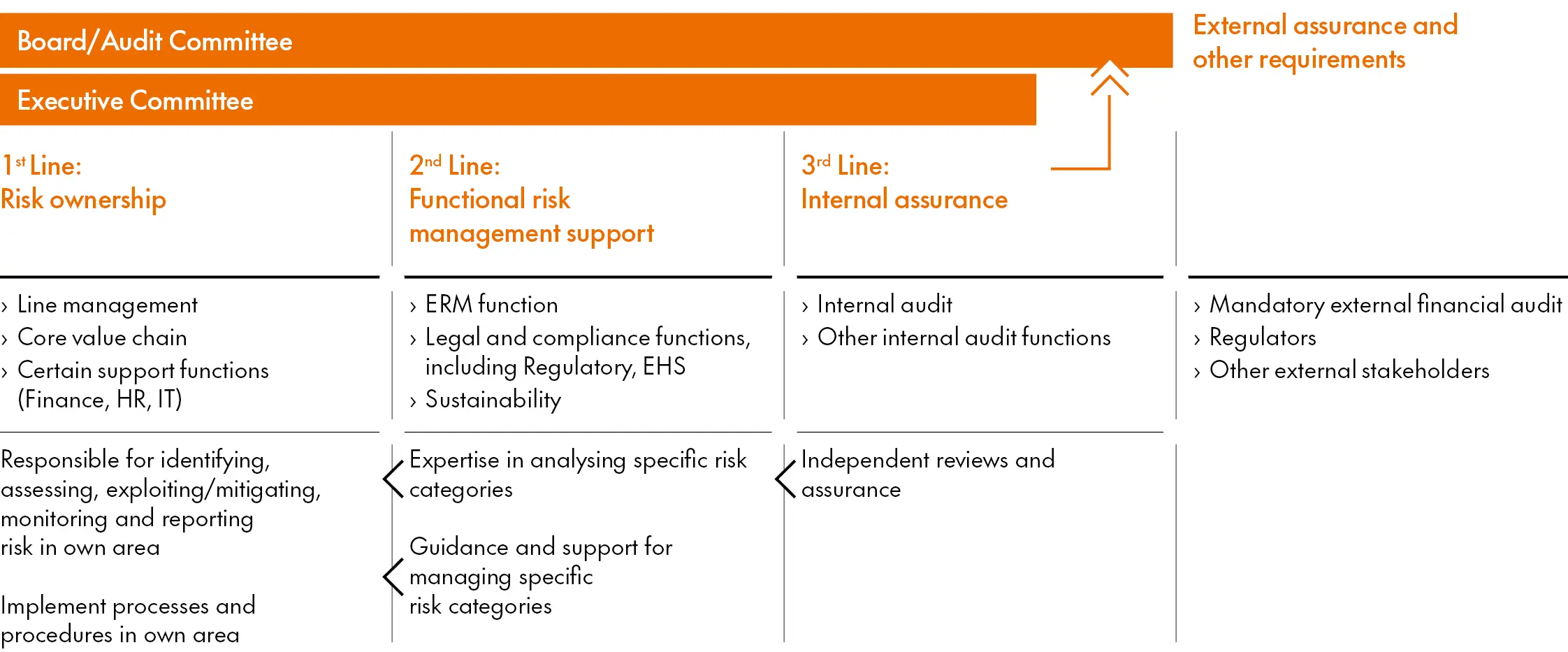

Risk management

Givaudan has established an internal risk management process based on the Givaudan Enterprise Risk Management Charter. It focuses on identifying and managing/exploiting risks.
Managing risk is an integral part of Givaudan’s business. Enterprise Risk Management (ERM) is the process of assessing, treating and monitoring the effects of uncertainty that may affect the achievement of Givaudan’s objectives, especially its publicly stated strategic objectives, or jeopardise Givaudan’s long-term business success. We operate a structured system of identifying, assessing and deciding on responses to mitigate key risks, and seek to consciously take the appropriate amount of risk, to manage these risks competently at the right level of the organisation, and to seize related business opportunities.
The Board of Directors defines the strategic risk management framework. This process is under the responsibility of the Executive Committee. The risk management process follows a structured assessment, review and reporting cycle that is coordinated by the Corporate Ethics & Compliance Officer to ensure a harmonised Group-wide approach.
For each identified strategic top-level Company risk a member of the Executive Committee is designated as the risk owner with the responsibility to manage the risk on a Group-wide basis. Once annually the Executive Committee reports to the Board on the risk management process, the strategic risks and the mitigation actions.
Givaudan’s ERM contributes to:
- safeguarding Company value and assets and a protection of shareholder interests
- exploiting strategic opportunities to further create Company value
- improving awareness amongst all key internal stakeholders of the nature and magnitude of the Company’s risks
- providing risk-based management information for effective decision-making
- improving compliance with good corporate governance guidelines and practices as well as applicable laws and regulations.
Enterprise Risk Management framework

Corporate internal audit provides assurance on the effectiveness of the risk management process.
Please see our latest 2024 Integrated Report for more information on our risk mitigation approach and how we use our strengths to turn these risks into opportunities.
Risk categories and response
STRATEGIC RISKS
Business model
> Definition
There is a risk that our business model might fail (e.g. affected by digitalisation or emergence of a new business model in our industry that we fail to grasp).
> Impact on value creation
If the Company’s business model became obsolete, value creation would cease.
> Mitigation measures
We regularly review our business model and strategy.
Customers
> Definition
There is a risk that customers’ behaviour, needs, internal organisations and/or expectations change (e.g. cost focus vs. innovation focus).
> Impact on value creation
If we do not react quickly and appropriately to changes in customer behaviour patterns this could lead to a decrease in market attractiveness of our products and therefore to a loss of revenue and/or profitability.
> Mitigation measures
We continuously engage with our stakeholders, especially with customers and suppliers.
Competition
> Definition
There is a risk posed by existing competitors as well as by new market entrants (e.g. on business model).
> Impact on value creation
If we do not pre-empt or react to risks posed by competitors, this could impact our competitive position and have financial consequences.
> Mitigation measures
We monitor the competitive landscape.
Consumer preferences
> Definition
There is a risk of change in consumer preferences, both in terms of product preferences and in the way consumers acquire and experience products.
> Impact on value creation
If we do not anticipate changing consumer preferences, also in terms of sustainability requirements, there may be reduced demand for our customers’ products and, indirectly, our own.
> Mitigation measures
- We regularly review trends and their impacts on our environment.
- We adapt to changing environments thanks to our innovative capabilities.
Innovation
> Definition
There is a risk of not investing sufficiently in responsible innovation capability, strategy and environment to capture new breakthroughs and trends and to safeguard competitive advantage.
> Impact on value creation
If we do not invest sufficiently into innovation capability, strategy and environment, Givaudan could become less competitive.
> Mitigation measures
We monitor the innovation environment, adapt our strategy as required and invest in our innovation capabilities.
Geopolitical
> Definition
There is a risk arising from political changes globally, with potential ramifications on operations and commerce. This includes the possibility of restrictions or impossibilities in engaging with countries in turmoil or at war, leading to broader destabilisation in those regions.
> Impact on value creation
If we do not appropriately monitor geopolitical destabilisation, it may impede our operations, disrupt supply chains, and jeopardise our business in affected countries, resulting in significant loss.
> Mitigation measures
We monitor geopolitical developments and adapt our strategy and continuity plans accordingly.
FINANCIAL RISKS
Market risk
> Definition
This category of risk pertains principally to risks associated with currency, inflation, interest rates and prices.
> Impact on value creation
Givaudan is exposed to the effect of changes in foreign currency rates, the impact of currency fluctuations due to mismatches between the currencies in which our operating costs are incurred and those in which revenues are received. Otherwise, the high level of visibility around financial risks facilitates informed and timely decision-making.
> Mitigation measures
- Close collaboration with the various stakeholders within the Givaudan organisation ensures the appropriate level of understanding and management of financial risks related to customers.
- The use of financial derivatives hedges the Group’s key financial risks, most notably foreign exchange and interest rate risk.
- Operating centres of expertise at Group level allows us to oversee the execution of the Financial Risk Management Policies.
- Investing in technology to ensure efficient and well-controlled processes.
Credit risk and liquidity risk
> Definition
This risk refers to our ability to raise debt and/or equity financing, which is significantly influenced by general economic conditions, developments in credit markets, equity market volatility and our credit rating.
> Impact on value creation
Failure to bring financing at reasonable rates could prevent us from realising our strategy and have a negative impact on our competitive position.
> Mitigation measures
- We have clearly defined policies in relation to the management of financial risks that are applicable to all Group companies.
- We maintain a broad network of financing sources, including bank financing as well as debt capital markets in different geographies.
- We maintain a broad network of financing sources, including bank financing as well as debt capital markets in different geographies.
Tax risk
> Definition
We operate in a number of countries, all with different tax systems, and an international tax environment that is becoming more onerous, requiring increasing transparency and reporting.
> Impact on value creation
Dealing with tax-related challenges may divert resources and attention from core business operations, hindering overall operational efficiency and, consequently, value creation.
> Mitigation measures
- We have dedicated tax resources that are supported by a Group tax team throughout the Company.
- We seek to have multi-year tax agreements in the major tax jurisdictions where we operate.
- We seek external advisory opinions where relevant.
- We regularly engage with external advisors to stay up to date with changes in tax legislation.
CLIMATE RISKS
Emerging regulations/carbon-pricing mechanism
> Definition
Climate-related regulations are increasing worldwide by quantity and location. With our operations located in over 27 countries, the risk of exposure to emerging regulation is high. Givaudan is exposed to climate-related regulations that place a price on GHG emissions generated by our production sites by the use of fossil-fuel-sourced electricity and fuels.
> Impact on value creation
Any change in climate-change regulations (in particular through imposing mandatory GHG reductions) may have an economic impact such as increased cost of operation (e.g. for additional taxes on fuel, energy or carbon emissions) or increased cost of raw materials passed on by suppliers to Givaudan.
> Mitigation measures
- We reduce our dependence on fossil-based energy supply.
- We engage in energy-efficiency projects and procurement practices in renewable electricity.
- We build up climate positive botanical supply chains models thanks to regenerative agriculture approach.
Changing temperature
> Definition
Changes in weather patterns and increasing temperatures affect ecosystems and drive changes in biodiversity. We already see raw material supply chains becoming more volatile, uncertain and complex. Likely consequences include disruption in the supply of the raw materials; volatility of raw material prices; and increased demand for Naturals.
> Impact on value creation
Most of the natural ingredients sourced by Givaudan are not commodities, but specialities produced in small volumes. We have seen a significant increase of supply risk on iconic products such as vanilla, spices and florals portfolios. The potential financial impact is an increase in costs and a potential loss of revenue. This may negatively impact our ability to produce at competitive prices and in a timely manner, putting Givaudan at risk.
> Mitigation measures
- We have developed a business continuity plan for sourcing.
- Raw materials sourcing is integrated into the category management process.
- We have established a structured risk-mitigation strategy to anticipate raw material supply issues and supplier deficiencies.
- We deploy ad hoc regenerative farming practices at scale (incl. agroforestry) on cultivated strategic botanicals, allowing for more resilience to extreme weather conditions.
Drought
> Definition
Declining water quality, long-lasting droughts and increased water stress are all elements identified as material water risks faced by some of our operations and supply chains. Water scarcity will increase in frequency.
> Impact on value creation
Changes in precipitation could adversely impact our operations and may negatively impact our ability to produce at competitive prices and on time, which might decrease revenue. We have already experienced episodes of water supply disruption at our sites in Jaguaré, Brazil and Jigani, India. Disruption in the supply of the raw materials due to water-scarcity level and water stress increase in some regions. It has been identified as a major risk to the business and is reflected in the annual financial planning, since raw material prices impact our profitability margins.
> Mitigation measures
- Water efficiency projects are in place to reduce our water consumption and how we manage effluent discharge.
- Regular assessments of potential risks and back-up plans. We have set up additional water supply systems for a transitional period of time.
- We mitigate water risk and improve water quality management aspects in our supply chain and in our communities.
- We deploy ad hoc regenerative farming practices at scale (incl. cover cropping) on cultivated strategic botanicals, improving water retention capacity in soils.
- We complement our wild botanical supply with domestication and cultivation programmes.
HUMAN AND CHILD LABOUR
Human rights
> Definition
Risk that Givaudan, in the course of its business, uses or tolerates exploitative practices that violate human rights at our own operations or in our supply chain.
> Impact on value creation
Human rights violations by Givaudan or in our supply chain can have a wide impact on the world around us. It may result in severe reputational damage, loss of stakeholder relationship and financial penalties. Neglecting human rights in our supply chains may lead to damage/harm to the communities from which we source.
> Mitigation measures
- We have implemented a Group-wide human rights policy and programme.
- We have introduced human rights assessments and measures to identify and engage with vulnerable or marginalised groups.
- We are active members of Sedex.
- We have established leading ethical and social practices at our sites and in our supply chain.
- We are committed to the International Bill of Human Rights, ILO's Declaration on the Fundamental Principles and Rights at Work, and the ILO Tripartite Declaration of Principles concerning Multinational Enterprises and Social Policy.
- We respect and promote human rights in our operations and value chain, in line with the UNGP on Business and Human Rights and the OECD Guidelines for Multinational Enterprises on Responsible Business Conduct.
Child labour
> Definition
Risk that Givaudan, in the course of its business, uses or tolerates child labour at our own operations or in our supply chain.
> Impact on value creation
Violations related to child labour, whether committed by Givaudan or within our supply chain, can exert a profound influence on society. Such transgressions may culminate in significant reputational harm, strained stakeholder relations, and financial repercussions. Neglecting child labour in our supply chain has the potential to inflict damage upon the communities from which we source by harming children’s health and wellbeing, hindering their education, development and future livelihood.
> Mitigation measures
We follow relevant ILO Conventions related to minimum age and the worst forms of child labour (C138 and C182) and align our due diligence process and related programmes to the OECD Due Diligence Guidance for Responsible Business Conduct and the UNGPs on Business and Human Rights.
SUSTAINABILITY RISKS
Sustainable sourcing
> Definition
Risk of failing to understand demand and have sustainably sourced, biodegradable, traceable and renewable ingredients as demanded by customers.
> Impact on value creation
Failing to optimise our impact carries a number of risks: reduced availability of resources would lead to cost increases and a loss of profitability; failing to provide customers with the sustainably sourced, biodegradable, non-fossil based, traceable and renewable ingredients they demand could cause them to turn to competitors, resulting in a loss of business. Failure to source sustainably can also result in damage to our reputation.
> Mitigation measures
We have implemented programmes for sustainable sourcing and are monitoring their performance. These include our Responsible Sourcing Policy and our Sourcing4Good programme.
Public sustainability commitments/‘greenwashing’
> Definition
We may not be able to recruit and/or retain the qualified personnel we require.
> Impact on value creation
Without qualified personnel, we may not reach our stated objectives and we may lose customers and suffer reputational loss.
> Mitigation measures
Our HR function has a number of processes and programmes to ensure we can brand ourselves as an attractive employer and recruit and retain talent where we require it.
TALENT RISKS
Talent acquisition and retention
> Definition
We may not be able to recruit and/or retain the qualified personnel we require.
> Impact on value creation
Without qualified personnel, we may not reach our stated objectives and we may lose customers and suffer reputational loss.
> Mitigation measures
Our HR function has a number of processes and programmes to ensure we can brand ourselves as an attractive employer and recruit and retain talent where we require it.
Diversity, equity and inclusion
> Definition
We may not sufficiently cater to and include diverse talent, including women, people from high growth markets and new talents required for new areas of the business.
> Impact on value creation
If we are not sufficiently diverse, equitable and inclusive, our reputation as a great place to work may suffer and we may be unable to attract or retain scarce talent.
> Mitigation measures
- Our HR function has a number of processes and programmes in place to ensure DE&I.
- We have embedded diversity targets into our strategy and into the objectives for the long-term remuneration for our top management. Performance against these targets is reviewed, audited and published annually.
OPERATIONAL RISKS
Disruption of operations
> Definition
There may be a disruption in the supply of the raw materials we require for our production or volatility of raw material prices. Such disruptions may be caused by external factors such as geopolitical tensions or war, pandemic, climate change or a breakdown at one or more of our suppliers for other reasons.
> Impact on value creation
A breakdown of our operations, especially at a big site may threaten our ability to produce and deliver quality products/services at competitive prices on a timely basis.
> Mitigation measures
- We have implemented comprehensive business continuity planning and crisis preparedness programmes for both divisions.
- We develop visual risk portfolios to show mitigation measures and progress on improvement actions.
Disruption of supply chains/suppliers
> Definition
There may be a disruption in the supply of the raw materials we require for our production or volatility of raw material prices. Such disruptions may be caused by external factors such as geopolitical tensions or war, pandemic, climate change or a breakdown at one or more of our suppliers for other reasons.
> Impact on value creation
Such a disruption may negatively impact our ability to produce at competitive prices and in a timely manner.
> Mitigation measures
- We monitor and manage supply-chain risks arising from raw materials.
- We implement a cross-functional risk management process that is integrated with global supply chain management, thus enabling us to mitigate raw materials sourcing risks.
Environment, health & safety and operational risk management
> Definition
There is a risk if Givaudan operates in a way that is harmful to people, the environment and/or causes community nuisance (e.g. odour emissions, wastewater).
> Impact on value creation
This could result in fines, reputational impact or even the loss of the Company’s licence to operate a given site.
> Mitigation measures
- Our Environment, Health and Safety (EHS) function regularly carries out comprehensive risk assessments at our production and major commercial sites.
- The EHS team is involved from the beginning on projects to support the design of all new building activities.
- We find and install new technologies for environmental protection in the area of odour emissions control.
Product recall because of quality/product safety
> Definition
There is a risk of a faulty product or one that is not compliant with regulations or is nonperforming (whether or not it causes consumer health issues).
> Impact on value creation
Such a risk could expose Givaudan to product recall, consumer health issues, customer complaints, warranty claims, returns and re-runs, product liability claims or litigation, which could in turn lead to loss of revenues, market share and business reputation.
> Mitigation measures
- We systematically evaluate all ingredients for both human and environmental safety prior to their inclusion in our palette of raw materials.
- Our global IT systems oversee product formulations, ensuring that raw materials are used as intended in our global production processes.
Information technology availability and integrity
> Definition
There is a risk of an IT system failure, whether intentional or unintentional, which could lead to the inaccessibility of systems or the corruption or loss of data.
> Impact on value creation
With increased digitalisation and use of AI, digital tools, and communication technologies, IT systems failure can lead to business interruption and customer business disruption, potentially resulting in the loss of customers or revenues.
> Mitigation measures
We have instituted a large number of IT and IT Security processes including structural architectural measures, behavioural measures and disaster recovery plan.
Cyber-attack
> Definition
There is a risk of a malicious cyber-attack on Givaudan’s own or third party information technology or operational technology systems that are handling our data.
> Impact on value creation
A cyber-attack can lead to misappropriation of assets (e.g. cash or IP/formulas) usually coupled with a request for a ransom. This has the potential to seriously impact our operations and the ability to serve our customers, which could result in increased costs, lost revenue and reputational damage.
> Mitigation measures
- We have increased our Information security investments to strengthen our security posture.
- We have adopted a risk-based approach and the implementation of a Zero Trust Architecture.
- We have increased our Information Security awareness efforts to further strengthen the Information security culture across the Company.
- We are continually monitoring cybersecurity risks.
LEGAL, COMPLIANCE AND REGULATORY RISKS
Unethical behaviour/reputation risk
> Definition
There is a risk that protected or confidential information (including Givaudan strategic information or formulas) be disclosed in an unauthorised way by Givaudan personnel or business partners.
> Impact on value creation
Any disclosure of confidential information could lead to reputational as well as financial damage to Givaudan, in particular if such information is also price sensitive.
> Mitigation measures
- We have comprehensive systems in place to protect Givaudan’s confidential information and guard against unauthorised disclosure.
- We have an insider dealing policy and programme in place regarding the disclosure or acting on price-sensitive information.
Confidentiality
> Definition
There is a risk that protected or confidential information (including Givaudan strategic information or formulas) be disclosed in an unauthorised way by Givaudan personnel or business partners.
> Impact on value creation
Any disclosure of confidential information could lead to reputational as well as financial damage to Givaudan, in particular if such information is also price sensitive.
> Mitigation measures
- We have comprehensive systems in place to protect Givaudan’s confidential information and guard against unauthorised disclosure.
- We have an insider dealing policy and programme in place regarding the disclosure or acting on price-sensitive information.
Increasing regulation
> Definition
There is a risk of increased regulation and changes in existing regulation leading to many ingredients being banned or subjected to additional controls/labelling or taxation. One example may be increasing regulation on greenhouse gas emissions (GHG).
> Impact on value creation
Increasing and/or overly strict regulation may limit our ability to produce in certain countries, lead to an increased need for reformulation and undermine Givaudan’s ability to carry out its business and innovate products and processes.
> Mitigation measures
Regulatory organisations in both divisions work on compliance with all regulations and on the review of any new ones that might come into effect.



